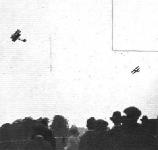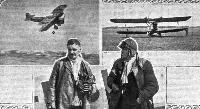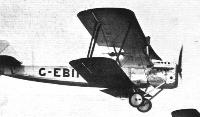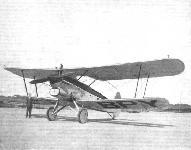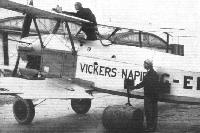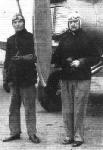
Vickers Type 71 Vixen
В 1922 году компания "Vickers" в инициативном порядке приступила к разработке двухместного военного многоцелевого биплана. Прототип, получивший обозначение Type 71 Vixen Mk I и оснащенный 450-сильным (336 кВт) ПД Napier Lion I, поднялся в воздух в начале 1923 года.
После официальных испытаний было решено, что самолет можно переделать в дневной бомбардировщик. У самолета Vixen I удлинили фюзеляж, установили бомбардировочное оборудование, и он повторно вышел на испытания, но уже под обозначением Type 87 Vixen Mk II. Хотя результаты тестов были положительными, самолет сочли более подходящим для использования в качестве вооруженного разведчика. Министерство авиации заказало шесть таких машин под обозначением Type 94 Venture. Однако по прямому назначению они не применялись, а были распределены среди различных подразделений британских ВВС для различных экспериментов.
Продолжение разработки самолета Vixen привело к созданию варианта Type 91 Vixen Mk III. Близкий по конструкции Venture, он имел крыло увеличенной площади и был оснащен двигателем Lion II с повышенной степенью сжатия, что улучшало высотные характеристики машины. Самолет испытывали как с колесным, так и с поплавковым шасси. В 1924 году Vixen Mk III получил удлиненный фюзеляж и 650-сильный (485 кВт) ПД Rolls-Royce Condor III, превратившись в Type 105 Vixen Mk IV. Позднее в том же году несколько доработали конструкцию планера, в очередной раз изменив обозначение на Type 126 Vixen Mk VI.
Компании "Vickers" удалось добиться успеха с самолетом Vixen на зарубежном рынке. Десять Vixen Mk I с двигателями Napier Lion были построены для Португалии под обозначением Type 93 Valparaiso Mk I, а еще четыре - с двигателями Rolls-Royce Eagle - под обозначением Type 92 Valparaiso Mk II.
Один из этих самолетов был возвращен компании в 1929 году для установки двигателя Gnome-Rhone Jupiter VIa, а затем возвращен для испытаний португальскими ВВС. Как минимум 13 таких машин были построены в Португалии по лицензии; они получили обозначение Type 168 Valparaiso Mk III.
Чили приобрела один Valparaiso Mk I для эксплуатационных испытаний, после чего заказала в 1925 году 18 машин, имевших незначительные отличия и оснащенных 500-сильным (373 кВт) ПД Lion V, которым присвоили обозначение Type 116 Vixen Mk V.
У использовавшихся за рубежом Vixen были проблемы с крылом и оперением, каркас которых был выполнен из дерева. Поэтому под обозначением Vixen Mk VII планировалось создать самолет с цельнометаллическим каркасом. Однако это обозначение изменили на Type 130 Vivid, параллельно разрабатывая еще один вариант с металлическим каркасом, названный Type 131 Valiant.
Оба самолета остались в единственном экземпляре. Vivid был оснащен 500-сильным (373 кВт) ПД с высокой степенью сжатия Lion VA, а на Valiant был установлен 455-сильный (339 кВт) ПД Bristol Jupiter VI.
Позднее Vivid оснастили поплавковым шасси и 540-сильным (403 кВт) ПД Napier Lion XI.
Описание:
- Vickers Type 71 Vixen
- Flight, July 1928
THE VICKERS "VIVID”
Фотографии
-
Мировая Авиация 248
Это один из 10 бипланов Valparaiso I, поставленных Португалии и служивших в подразделении Grupo de Esquadrilhas de Aviacao Republics (GEAR) в Амадора в качестве разведчиков-бомбардировщиков. Позднее GEAR была преобразована в Grupo de Aviacao de lnformacao (GAI).
-
Flight 1923-11 / Flight
At Croydon "review": The Vickers "Vixen" day bomber. This machine is fitted with a Napier "Lion" engine. Note the gravity petrol tanks in the top plane.
-
Flight 1924-07 / Flight
AT THE R.A.F. PAGEANT: New two-seater fighter biplane which took part in the "Fly Past." The Vickers "Venture" (Napier "Lion").
-
Flight 1927-07 / Flight
THE MARCHIONESS OF TOWNSHEND'S AERIAL FETE: The mimic battle between the Gloucester "Gamecock" and the Vickers "Venture."
Другие самолёты на фотографии: Gloster Gamecock - Великобритания - 1925
-
Flight 1926-12 / Flight
Vickers "Vixen" Military Two-seater (Napier "Lion" Engine).
-
Мировая Авиация 248
Бипланы Vixen III в 1925-1927 годах трижды принимали участие в проводившихся в Великобритании Королевских авиагонках.
-
Flight 1926-07 / Flight
Регистрационный номер: G-EBIP [5] The King's Cup: A similar Vickers "Vixen" to that shown, with 450 h.p.. Napier "Lion," is entered this year.
-
Flight 1924-08 / Flight
Регистрационный номер: G-EBIP [5] THE VICKERS "VIXEN": On the left Sqdn.-Ldr. Payn crossing the finishing line, fifth under the handicap, and, on the right, the "Vixen" taxying in. Below: Sqdn.-Ldr. Payn and his passenger, Mr. J. Wyatt.
-
Flight 1927-06 / Flight
Регистрационный номер: G-EBIP [5] DAVID AND GOLIATH: Considerable amusement was caused at Bournemouth on Whit Monday by a heat in which the Halton "Mayfly" (30-h.p. Bristol "Cherub") was racing against the Vickers "Vixen III" (500 h.p. Napier "Lion") (shown).
-
Flight 1926-07 / Flight
Регистрационный номер: G-EBIP [5] SECOND IN THE KING'S CUP RACE: Two views of the Vickers "Vixen III" (Napier "Lion"), piloted by Flt.-Lieut. E. R. C. Scholefield, who came in only 22 secs. behind Broad.
-
Flight 1927-08 / Flight
Регистрационный номер: G-EBIP [5] THIRD MAN IN THE KING'S CUP RACE: Flight-Lieut. Scholefield and his Vickers "Vixen" with Napier "Lion" engine.
-
Air Enthusiast 1998-01 / R.Niccoli - Atlantic Sentinels
A Vickers Valparaiso I, export model of the Vixen, ten of which were purchased in 1923.
-
Flight 1924-08 / Flight
The Vickers "Valparaiso" military two-seater, with Napier "Lion" engine.
-
Flight 1928-09 / Flight
THE PORTUGUESE FLIGHT TO AFRICA: Four Vickers "Valparaiso" (Napier "Lion") biplanes of the Portuguese Military Air Service, the type on which Capts. Pais Ramos and Oliveira Viegas are flying from Lisbon to Mozambique via Portuguese Guinea and Angola.
-
Air Enthusiast 1998-01 / R.Niccoli - Atlantic Sentinels
One of 13 OGMA/Vickers Valparaiso IIIs modified from 1933, and operated by the GAI at Amadora.
-
Flight 1928-07 / Flight
THE VICKERS "VIVID"
-
Flight 1929-03 / Flight Advertisements
Регистрационный номер: G-EBPY [3] The photograph shows the Vickers-Napier "Vivid" military two-seater which Flight-Lieut. E. R. C. Scholefield, A.F.C., D.C.M., on the 6th September, 1928, flew in one day from Brooklands to Bucharest in the astonishing flying time of ten hours. Like all Vickers machines it is of course doped with Cellon.
-
Flight 1928-09 / Flight
Регистрационный номер: G-EBPY [3] ENGLAND-ROUMANIA IN A VICKERS' "VIVID": In connection with some demonstration flights given by aircraft firms of various countries to the Roumanian Government, a splendid flight was made by Flight-Lieut. J. Scholfield on a Vickers "Vivid" long distance Reconnaissance machine (Napier "Lion") shown here. Leaving Weybridge just before 6 a.m. on September 6, he passed over Brussels 18 mins. later and landed at Nuremberg at 9.55 a.m. After a short stop he proceeded over Austria-Hungary to Belgrade (2.55 p.m.) and reached Bucharest at 5.55 p.m. (E.S.T.) ; thus covering over 1,300 miles in 10 hours.
-
Aeroplane Monthly 1997-03 / P.Jarrett - Vickers Valiant biplane /Limited editions/ (7)
Регистрационный номер: G-EBPY [3] The Valiant’s structure had much in common with that of its sister, the Vivid, seen here, and its float chassis would have been similar.
-
Aeroplane Monthly 1997-03 / P.Jarrett - Vickers Valiant biplane /Limited editions/ (7)
Another view of the Valiant at Brooklands on March 18, 1927. It was powered by a 492 h.p. Bristol Jupiter VI radial engine.
-
Flight 1927-06 / Flight
Vickers "Valiant" (Bristol "Jupiter"). This machine represents Vickers' interpretation of the General Purpose type specification. Aerodynamically the machine is a clean design of fairly orthodox type, with large span, and consequently a high value of the ratio span2 : weight. This makes for low induced drag, and results in good climb. Structurally the "Valiant" is of all-metal construction, of forms developed by this firm during the last few years. Large balanced control surfaces result in great controllability at low speeds. Note also the careful streamlining of the engine cylinders.
-
Aeroplane Monthly 1997-03 / P.Jarrett - Vickers Valiant biplane /Limited editions/ (7)
Another view of the Valiant at Martlesham in April 1927. Note the two 112lb bombs carried during the trials.
-
Aeroplane Monthly 1997-03 / P.Jarrett - Vickers Valiant biplane /Limited editions/ (7)
The Valiant at Brooklands on March 18, 1927, with 4° of sweepback added to the mainplanes, but before the rudder height was increased.
-
Aeroplane Monthly 1997-03 / P.Jarrett - Vickers Valiant biplane /Limited editions/ (7)
The Valiant at the Aeroplane and Armament Experimental Establishment at Martlesham Heath, Suffolk, in April 1927.
-
Flight 1928-05 / Flight
REPRESENTATIVE TYPES OF BRITISH AIRCRAFT: 3. The Vickers "Valiant-Jupiter" general purpose two-seater.
-
Aeroplane Monthly 1997-03 / P.Jarrett - Vickers Valiant biplane /Limited editions/ (7)
Another view of the Valiant taxying at the 1927 RAF Display.
-
Aeroplane Monthly 1997-03 / P.Jarrett - Vickers Valiant biplane /Limited editions/ (7)
The Valiant taxies past during the RAF Display at Hendon on July 2, 1927, bearing the New Type number 11.
-
Aeroplane Monthly 1997-03 / P.Jarrett - Vickers Valiant biplane /Limited editions/ (7)
The Vickers Valiant flying at the 1927 RAF Display at Hendon on July 2.
-
Aeroplane Monthly 1997-03 / P.Jarrett - Vickers Valiant biplane /Limited editions/ (7)
Vickers Type 131 Valiant
- Фотографии



